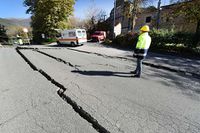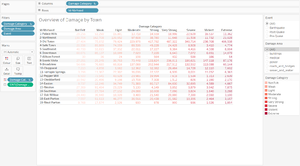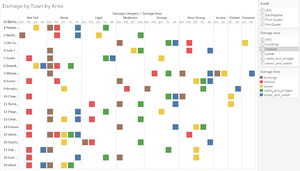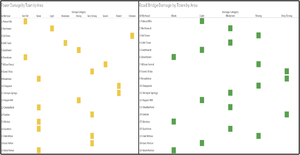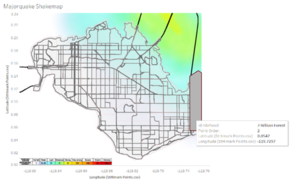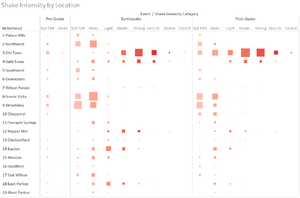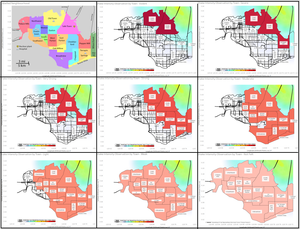Difference between revisions of "IS428 AY2019-20T1 Assign Chua Xuan Ni, Rachel TASK & QUESTIONS"
(Created page with "<div style=background:#376E6F border:#8EE4AF #top> 200px <font size = 5; color="#FFFFFF">IS428 VAST 2019 Mini Challenge 1 </font> </div> <!--MAIN HEADE...") |
|||
| Line 31: | Line 31: | ||
==== Emergency responders will base their initial response on the earthquake shake map. Use visual analytics to determine how their response should change based on damage reports from citizens on the ground. How would you prioritize neighborhoods for response? Which parts of the city are hardest hit? Limit your response to 1000 words and 10 images. ==== | ==== Emergency responders will base their initial response on the earthquake shake map. Use visual analytics to determine how their response should change based on damage reports from citizens on the ground. How would you prioritize neighborhoods for response? Which parts of the city are hardest hit? Limit your response to 1000 words and 10 images. ==== | ||
<br> | <br> | ||
| − | ''How would you prioritize neighborhoods for response?'' | + | '''''How would you prioritize neighborhoods for response?''''' |
<br> | <br> | ||
I would prioritize the neighborhood for response based on the different damage category – Buildings, Medical, Power, Roads & Bridges and Sewer & Water. As seen from the image below, it shows the overview of the town’s damage by category based on the specific event – pre-quake, earthquake and post-quake. The values in a darker shades of red represents higher damage and the values in each cell is the count of that particular damage category level felt. | I would prioritize the neighborhood for response based on the different damage category – Buildings, Medical, Power, Roads & Bridges and Sewer & Water. As seen from the image below, it shows the overview of the town’s damage by category based on the specific event – pre-quake, earthquake and post-quake. The values in a darker shades of red represents higher damage and the values in each cell is the count of that particular damage category level felt. | ||
| Line 56: | Line 56: | ||
<br><br> | <br><br> | ||
| − | ''Which parts of the city are the hardest hit? '' | + | '''''Which parts of the city are the hardest hit?''' '' |
<br> | <br> | ||
As we know that the earthquake happens on 8 April, my visualization would focus on what happens before, during and after the earthquake. I have categorized them under Pre-Quake, Earthquake and Post-Quake for all data collected before 8 April, on 8 April and after 8 April respectively. This is an overview of the Shake Intensity by Location. The size of the squares refers to the count of shake intensity category whereas the darker the shade of red signifies the higher importance should be given. | As we know that the earthquake happens on 8 April, my visualization would focus on what happens before, during and after the earthquake. I have categorized them under Pre-Quake, Earthquake and Post-Quake for all data collected before 8 April, on 8 April and after 8 April respectively. This is an overview of the Shake Intensity by Location. The size of the squares refers to the count of shake intensity category whereas the darker the shade of red signifies the higher importance should be given. | ||
Revision as of 21:47, 11 October 2019
|
|
|
|
|
|
Contents
Question 1
Emergency responders will base their initial response on the earthquake shake map. Use visual analytics to determine how their response should change based on damage reports from citizens on the ground. How would you prioritize neighborhoods for response? Which parts of the city are hardest hit? Limit your response to 1000 words and 10 images.
How would you prioritize neighborhoods for response?
I would prioritize the neighborhood for response based on the different damage category – Buildings, Medical, Power, Roads & Bridges and Sewer & Water. As seen from the image below, it shows the overview of the town’s damage by category based on the specific event – pre-quake, earthquake and post-quake. The values in a darker shades of red represents higher damage and the values in each cell is the count of that particular damage category level felt.
Next, as repair works requires specialized skillsets, I would analyze the neighborhood that requires prioritization based on the damage category. The image below shows the highest count of damage category for that particular neighborhood. For example, for Palace Hills, the highest count for damage category of Power, Building, Medical, Sewer & Water and Roads & Bridges is Not Felt, Weak, Weak, Weak and Light respectively. Hence, for such neighborhood, prioritization tend to be lower. On the other hand, for Old Town, the highest count for damage category of Power, Building, Medical, Sewer & Water and Roads & Bridges is Extreme, Moderate, Very Strong, Strong and Strong respectively. Hence, prioritization tend to be higher.
You may also select a particular damage area for a relevant department to look at the prioritization. For instance, by looking at Power, you can see that Old Town, Chapparal and Terrapin Springs require more prioritization compared to other neighborhood whereas for Roads & Bridges, Scenic Vista, Broadview and Easton require more prioritization as compared to other neighborhood.
Therefore, given this visualization, I would think that the top neighborhoods to prioritize for each damage area are:
• Building: Wilson Forest, Chapparal and Broadview
• Medical: West Parton, Old Town and Safe Town
• Power: Old Town, Chapparal and Terrapin Springs
• Roads and Bridges: Scenic Vista, Broadview and Easton
• Sewer and Water: Wilson Forest, Broadview, Southern, Scenic Vista and Safe Town
Note that while 7-Wilson Forest have very limited data as compared to the rest, since they are relatively close to the earthquake location on the shake map. I have decided to take these limited data into considerations as well.
Which parts of the city are the hardest hit?
As we know that the earthquake happens on 8 April, my visualization would focus on what happens before, during and after the earthquake. I have categorized them under Pre-Quake, Earthquake and Post-Quake for all data collected before 8 April, on 8 April and after 8 April respectively. This is an overview of the Shake Intensity by Location. The size of the squares refers to the count of shake intensity category whereas the darker the shade of red signifies the higher importance should be given.
We can see that there is nothing particularly special with the Pre-Quake data since the shake intensity category are low. From this, focusing on the Earthquake and Post-Quake data, we can see that Old Town and Safe Town has been hit the hardest as the squares are huge and dark red. On the other hand, Northwest, Scenic Vista and Broadview seems to be affected the least as the squares are huge for those with lighter shades of red. From the picture below, we can also see that the more severe the shake intensity category, the lesser the affected neighborhoods.
Therefore, to rank the hardest hit city, it would be:
• Old Town, Safe Town; followed by
• Pepper Mill; followed by
• East Parton, Wilson Forest; followed by
• Easton, Cheddarford, Terrapin Springs; followed by
• Weston, West Parton, Chaparral, Broadview, Scenic Vista; followed by
• Northwest, Downtown, Southon, Oak Willow; followed by
• Palace Hills and Southwest
Question 2
Use visual analytics to show uncertainty in the data. Compare the reliability of neighborhood reports. Which neighborhoods are providing reliable reports? Provide a rationale for your response. Limit your response to 1000 words and 10 images.
Uncertainty is when an analyst is unable to tell if the neighborhood is in trouble or not based on the given data or when an analyst is unable to tell how much the place is in trouble.
